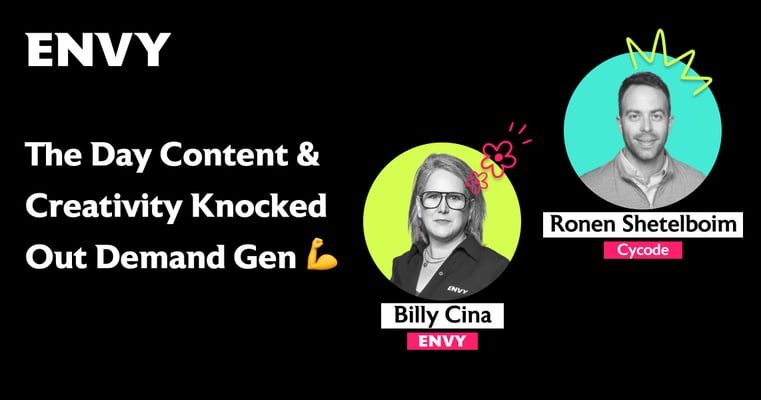
2025 B2B Marketing Budgets Are Shifting–As Always
If there’s one thing we’ve been tirelessly fighting for ever since Envy started, it’s for content to have more (or at least equal) power over paid activities. And it looks like this year, the gods, CEOs and CMOs have finally wisened up–just in time for you to still update your marketing budget for 2025. You can thank us later.
Or shall we say, let’s thank GenAI. Because today, everyone can say:
“In the ever-evolving threat landscape…” or
“5 ways to leverage innovation and deliver scalable solutions…”
And as much as it’s tiring to see these posts, it’s exactly this AI-generated content that has flooded the market with the same boring, surface-level stuff, making it harder than ever to stand out, and necessary to finally do so.
So, where should your 2025 marketing budget actually go? I spoke with Ronen Shatelboim, SVP of Marketing at Cycode, to break down what it means to succeed in B2B marketing today, and how to make your budget work for it.
And if you prefer to listen, here’s the video:
Marketing budget breakdown for 2025
Does your marketing budget look like this?
Because it shouldn’t. But it also shouldn’t be going all for just one activity. Paid media teams, including demand gen, used to dominate the budget (and headcount), but it’s finally time for creative and messaging teams to shine and take center stage—and for good reason. Because according to Ronen:
“Demand gen still matters, but only when paired with killer content and smart distribution.”
So here’s how to rethink your marketing budget (at least according to us):
- Messaging & creative first! – Get your narrative straight. Invest in top-notch content including videos that tell your story.
- Demand gen & paid media – Distribute that content strategically to amplify your reach.
- Continuous testing & optimization – Use performance data to adjust, improve, and scale.
So if you’re just shaking your head with disbelief, below’s an explanation as to why it might be worth rethinking where you marketing dollars are going (not necessarily in the same order):
2025 Marketing budget: paid campaigns
Demand gen isn’t dead. But the days of running campaigns in isolation, without thoughtful content or messaging, are over. Buyers are spread across so many platforms, that you risk losing too many opportunities if you’re only focusing on the giant leaders. By the way, I’ve already written about B2B alternatives to demand gen.
Long gone are the days when a single ebook and a few LinkedIn ads could fuel your entire funnel. The market is so oversaturated that these cookie-cutter approaches are simply wasting your marketing dollars. If your paid campaigns look like everyone else’s, you’re wasting your budget. Ronen said it best:
“The techniques that used to work for demand gen alone just don’t work anymore. There’s so much content out there that you can’t tell what’s authentic and what’s AI-generated. Marketing teams need to work smarter, not harder.”
2025 Marketing budget: (tons of) content
Paid activities are cool for attracting new leads, but what are you actually using for your ads? Well…. If that isn’t content??
Truth is, content has always been the main make it or break it for your ads performance but it was never given enough attention. And the genAI fluff finally makes it obvious–content-driven marketing backed by strong storytelling delivers. That’s why your creative should never be an afterthought.
“Don’t throw together AI-generated content just because it’s easy. Be original. Share real-life industry experiences. Meet your customers where they are and show that you understand their problems.”
I’ve shared plenty of ideas for content repurposing, ungating your content & creative messaging in the past, but here are some general tips that can help you make writing and creating easier and know what to write about in the first place:
- Go out and meet your IPC where they actually hang out instead of researching their pain points online. Go to conferences, industry events, try and set up 1-to-1s to learn as much as you can directly from the source;
- Did you ever ask your sales team what they talk about with prospects? Because that’s pretty much a goldmine of content ideas. What are the frequently asked questions they repeat over and over again?
- Speak to your Customer Success teams. Learn what customers love about you and what are their gripes?
- Ask a friend who meets your ICP criteria to take a walk around your website. What do they understand about your offering? What are they missing in order to compel them to talk to your sales team?
2025 Marketing budget: messaging
Too many B2B companies still think they can skip the hard work of defining their brand and messaging—as if demand gen alone will save them. Spoiler: It won’t. You should in fact start your campaign and budget planning with, “Does our messaging differentiate us?”. If not, you need to allocate budget to working with a professional who can help.
“You can’t be ‘just okay’ and expect to hit your targets. If your brand and messaging aren’t clear, your competitors will eat you for breakfast, lunch, and dinner.”
No matter the industry you’re in (but if it’s tech, it’s worse), the competition is so vast, there is no room for bland messaging. Unless you’re the big player, then you can ride the wave of your popularity and pay less attention to your messaging. I don’t necessarily recommend that and I definitely don’t understand that, but it’s what the big players do, I’ve spoken about it with no other that Peep Laja, CEO of Wynter, a tool that helps you test your messaging on real subjects:
2025 Marketing budget: testing
If there’s one thing marketers who come to Envy for help have in common, it’s sticking to what’s “working.” And sure, focusing on proven strategies sounds safe—but it’s often the fastest way to fall behind. If you think about the pace of all new tools, platforms, strategies and whatnot shaking up the industry, you don’t really want to get too sentimental about the past. Here’s how you can change it:
- Explore new channels
I know LinkedIn and Google Ads playbook feels comfortable. You’ve got the benchmarks, the reports, and the know-how. But your buyers know it so well too, they’re tired and off to platforms like Reddit or podcasts. And it doesn’t mean you should move all your resources there. Start small. Allocate 10-15% of your paid budget to experiment with new platforms or ad formats. Run short campaigns, test a hypothesis, and measure success. If it works, scale. If it doesn’t, move on.
- Explore creatives and messaging, don’t forget 😉
- Regularly review performance (and be brutally honest)
The beauty of testing and optimization is that it’s never “done.” That’s also what sucks the most in marketing, true. But if something isn’t working, don’t be afraid to pull the plug and reallocate those dollars. At the same time, identify your high-performing campaigns and amplify them to maximize ROI.
How to build a content engine that works
Want to know the secret to driving traffic, leads, and pipeline consistently? Me too! There’s no silver bullet, but building a powerful content engine is most probably your best shot (pun intended!
Ronen’s team at Cycode uses what they call a Rolling Thunder strategy—which is a steady drumbeat of content campaigns launched under sub-brands, all tied back to their core business.
Here’s how it works for them:
- Create sub-brands or microsites to target different stages of your buyer’s journey.
- Launch content campaigns under those sub-brands regularly (think podcasts, ebooks, blog series, webinars).
- Amplify your campaigns with paid media to reach the right audience.
- Measure leading indicators like website traffic, demo requests, and pipeline growth to track progress.
Every time Cycode launches a campaign, they see a measurable uptick in traffic, leads, and pipeline. And the best part is, this approach keeps their brand top-of-mind, no matter where buyers are in the sales cycle.
2025 marketing budgets on a lean team
Worried you don’t have the headcount (same) or resources (always!) to pull this off? Or maybe you’re a one-person show? There’s a couple of things you can introduce to make it work:
- Reallocate budgets: Stop wasting money on underperforming tactics like big-ticket events that don’t deliver ROI.
- Grow with external partners: Use trusted vendors to fill gaps in production and creative work.
- Build a network: Collaborate with industry practitioners and influencers to amplify your reach.
You don’t need a huge team to create a big impact. You just need a smart allocation of resources and a clear plan.
So, how will you allocate your marketing budget in 2025?
The gods of marketing have finally answered our prayers. Now, it’s your turn to adjust your budget accordingly—or risk getting left behind.
If you want your marketing dollars to work harder in 2025, it’s time to think differently. Stop treating more money poured into demand gen channels as the solution to everything. Start investing in content, messaging, and creative—the foundation of all great campaigns.
And if you need help building a marketing strategy that actually works, let’s chat.







.png?width=352&name=marketing-events-to-attend-in-2024%20(1).png)